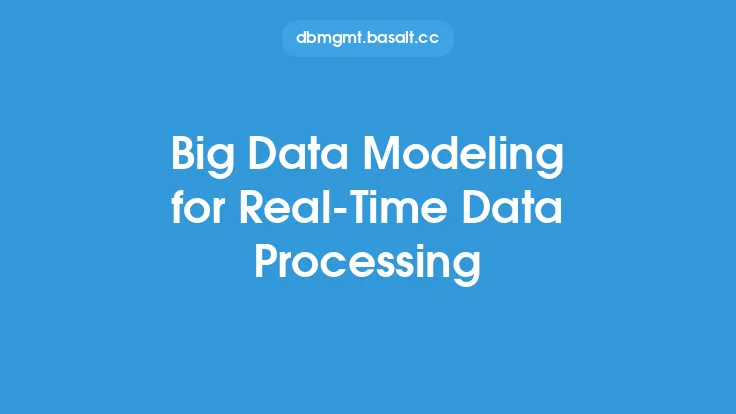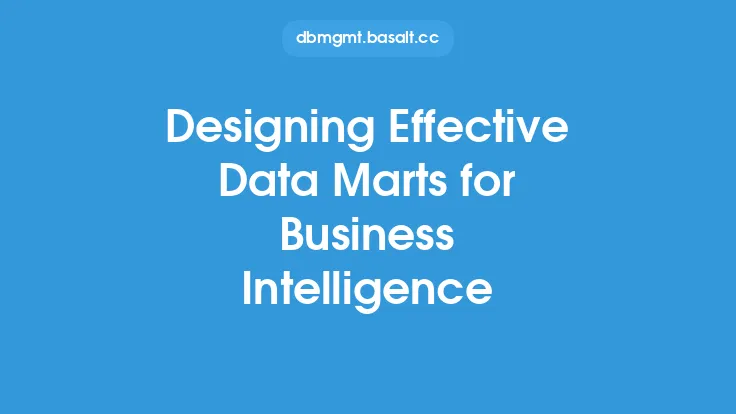Data lakes have become a crucial component in the big data landscape, providing a centralized repository for storing and managing large volumes of raw, unprocessed data. A well-designed data lake architecture is essential for efficient data storage, processing, and analysis. In this article, we will delve into the concept of data lake architecture, its components, and the best practices for designing a scalable and efficient data lake for big data storage.
Introduction to Data Lake Architecture
A data lake is a storage repository that holds a large amount of raw, unprocessed data in its native format. The data lake architecture is designed to handle the complexities of big data, providing a scalable and flexible framework for storing, processing, and analyzing large volumes of data. The primary goal of a data lake is to provide a centralized location for storing all types of data, including structured, semi-structured, and unstructured data. This allows organizations to store data in its raw form, without having to worry about the schema or data structure, and process it as needed.
Components of Data Lake Architecture
A typical data lake architecture consists of several components, including:
- Data Ingestion Layer: This layer is responsible for collecting data from various sources, such as social media, IoT devices, and log files, and ingesting it into the data lake.
- Data Storage Layer: This layer provides a scalable and flexible storage solution for storing large volumes of raw data. Popular storage solutions include Hadoop Distributed File System (HDFS), Amazon S3, and Azure Data Lake Storage.
- Data Processing Layer: This layer is responsible for processing and transforming the raw data into a usable format. Popular processing engines include Apache Spark, Apache Flink, and Apache Beam.
- Data Analytics Layer: This layer provides a platform for analyzing and visualizing the processed data. Popular analytics tools include Apache Hive, Apache Impala, and Tableau.
- Data Governance Layer: This layer is responsible for managing data quality, security, and compliance. Popular governance tools include Apache Atlas, Apache Ranger, and Data Governance Council.
Designing a Scalable Data Lake Architecture
Designing a scalable data lake architecture requires careful planning and consideration of several factors, including:
- Data Volume: The amount of data that needs to be stored and processed.
- Data Variety: The types of data that need to be stored, such as structured, semi-structured, and unstructured data.
- Data Velocity: The speed at which data is generated and needs to be processed.
- Data Veracity: The quality and accuracy of the data.
- Data Security: The security and compliance requirements for storing and processing sensitive data.
To design a scalable data lake architecture, organizations should follow these best practices:
- Use a Distributed Storage Solution: Use a distributed storage solution, such as HDFS or Amazon S3, to store large volumes of data.
- Use a Scalable Processing Engine: Use a scalable processing engine, such as Apache Spark or Apache Flink, to process large volumes of data.
- Use a Cloud-Based Platform: Use a cloud-based platform, such as Amazon Web Services or Microsoft Azure, to provide scalability and flexibility.
- Implement Data Governance: Implement data governance policies and procedures to ensure data quality, security, and compliance.
Data Lake Architecture Patterns
There are several data lake architecture patterns that organizations can use to design a scalable and efficient data lake. Some popular patterns include:
- Lambda Architecture: This pattern uses a combination of batch and real-time processing to provide a scalable and fault-tolerant architecture.
- Kappa Architecture: This pattern uses a single processing engine, such as Apache Kafka, to provide a scalable and real-time architecture.
- Delta Architecture: This pattern uses a combination of batch and real-time processing to provide a scalable and fault-tolerant architecture.
Benefits of Data Lake Architecture
A well-designed data lake architecture provides several benefits, including:
- Scalability: A data lake architecture can handle large volumes of data and scale as needed.
- Flexibility: A data lake architecture can store and process a variety of data types, including structured, semi-structured, and unstructured data.
- Cost-Effectiveness: A data lake architecture can provide a cost-effective solution for storing and processing large volumes of data.
- Improved Data Quality: A data lake architecture can provide improved data quality by storing data in its raw form and processing it as needed.
Challenges and Limitations of Data Lake Architecture
While a data lake architecture provides several benefits, it also presents several challenges and limitations, including:
- Data Governance: A data lake architecture requires careful data governance to ensure data quality, security, and compliance.
- Data Integration: A data lake architecture requires careful data integration to ensure that data is properly ingested, processed, and analyzed.
- Data Security: A data lake architecture requires careful data security to ensure that sensitive data is properly protected.
- Data Complexity: A data lake architecture can be complex and require specialized skills and expertise to design and implement.
Conclusion
A well-designed data lake architecture is essential for efficient data storage, processing, and analysis. By following best practices and using a scalable and flexible framework, organizations can design a data lake architecture that meets their needs and provides a competitive advantage. While a data lake architecture presents several challenges and limitations, it also provides several benefits, including scalability, flexibility, cost-effectiveness, and improved data quality. As the amount of data continues to grow, a data lake architecture will become an essential component of any big data strategy.





